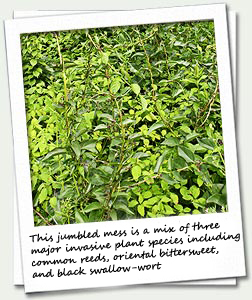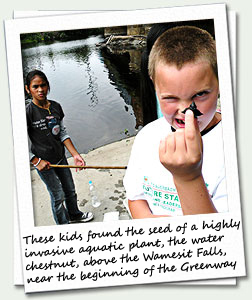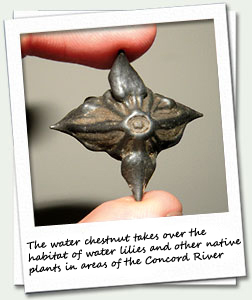Science: Plant Life - Native Plants vs. Non-Native - Invasive Plants
 Before Europeans settled in North America, forests, meadows, and rivers were a mix of native plants. These plants had always been here and were important to wildlife for shelter and food.
Before Europeans settled in North America, forests, meadows, and rivers were a mix of native plants. These plants had always been here and were important to wildlife for shelter and food.
Unfortunately, native plants have been increasingly threatened by non-native, invasive plants. Some of these plants were first brought by English settlers in the 1600s. Over time, more invasive species also came from other parts of Europe, Asia, and distant parts of North America.
Invasive plants invade habitats needed by native plants. They tend to be hardy and strong, making it difficult and sometimes impossible for native plants to compete.
After a forest is cut down and the ground is dug up or stripped of its soil and root structure, we refer to it as “disturbed”. If it is not tended to, it is a wound open to the infection of invasive plant species.
Invasive plants cause many problems including:
- Habitat loss.
- Shading and choking out of native plant species.
- Causes of poor water quality due to eutrophication elevated water temperatures and low oxygen levels.�
- Poor diets for wildlife.
- Economic problems for local governments and organizations
- Hindered recreational activities
- Unsightly landscapes.�
 Some non-native plants have a very effective means of dispersing their seeds and can easily escape from gardens. Oriental bittersweet, for example, is a popular garden vine and decorative plant often used for making fall wreaths. It often finds its way into the wild when animals eat the seeds and deliver them to new locations where bittersweet can take root. This is called seed dispersal.
Some non-native plants have a very effective means of dispersing their seeds and can easily escape from gardens. Oriental bittersweet, for example, is a popular garden vine and decorative plant often used for making fall wreaths. It often finds its way into the wild when animals eat the seeds and deliver them to new locations where bittersweet can take root. This is called seed dispersal. 
Invasive plants overtake over thousands if not millions of acres of natural plant habitat every year and are altering our landscapes and ecosystems far faster than we can even think about controlling them.� Although some native species of wildlife are able to adjust to these changes, the negative effects on local ecosystems are growing out of control.� Some environmentalists say that invasive plants are here to stay, which can be a hard thing to swallow.� Meanwhile, others are hard a work trying to mitigate their expansion.
Ways to help:
- Educate your friends and family about invasive plants
- Identify concentrations of invasive plants and notify local environmental agencies
- Support and get involved with local groups to eradicate invasive plants
- Organize a removal project, using appropriate means

Gallerucella beetles live in the same habitat as purple loosestrife, a widespread invasive plant. The beetles are now raised and released to feed on the loosestrife, working as a safe biological method of control.


 Before Europeans settled in North America, forests, meadows, and rivers were a mix of native plants. These plants had always been here and were important to wildlife for shelter and food.
Before Europeans settled in North America, forests, meadows, and rivers were a mix of native plants. These plants had always been here and were important to wildlife for shelter and food.  Some non-native plants have a very effective means of dispersing their seeds and can easily escape from gardens. Oriental bittersweet, for example, is a popular garden vine and decorative plant often used for making fall wreaths. It often finds its way into the wild when animals eat the seeds and deliver them to new locations where bittersweet can take root. This is called seed dispersal.
Some non-native plants have a very effective means of dispersing their seeds and can easily escape from gardens. Oriental bittersweet, for example, is a popular garden vine and decorative plant often used for making fall wreaths. It often finds its way into the wild when animals eat the seeds and deliver them to new locations where bittersweet can take root. This is called seed dispersal. 
